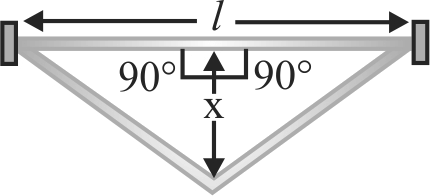366732
A rail track made of steel having length \(10\;cm\) is clamped on a railway line at its two ends (figure). On a summer day due to rise in temperature by \(20^\circ C\). It is deformed as shown in figure. Find \(x\) (displacement of the centre) if \({\alpha _{{\rm{steel }}}} = 1.2 \times {10^{ - 5}}/^\circ C\)
366733
Two steel rods and an aluminium rod of length \(l_{0}\) and equal cross section are joined rigidly at their eand as shown in the figure below. All the rods are in a state of zero tension at \(0^\circ C\). Find the length of the system when the temperature is raised to \(\Delta T\). Coefficient of linear expansion of aluminium and steel are \(\alpha_{a}\) and \(\alpha_{s}\) respectively. Young's modulus of aluminium and steel are \(Y_{a}\) and \(Y_{s}\) respectively \(\left(\alpha_{s}>\alpha_{a}\right)\).
366732
A rail track made of steel having length \(10\;cm\) is clamped on a railway line at its two ends (figure). On a summer day due to rise in temperature by \(20^\circ C\). It is deformed as shown in figure. Find \(x\) (displacement of the centre) if \({\alpha _{{\rm{steel }}}} = 1.2 \times {10^{ - 5}}/^\circ C\)
366733
Two steel rods and an aluminium rod of length \(l_{0}\) and equal cross section are joined rigidly at their eand as shown in the figure below. All the rods are in a state of zero tension at \(0^\circ C\). Find the length of the system when the temperature is raised to \(\Delta T\). Coefficient of linear expansion of aluminium and steel are \(\alpha_{a}\) and \(\alpha_{s}\) respectively. Young's modulus of aluminium and steel are \(Y_{a}\) and \(Y_{s}\) respectively \(\left(\alpha_{s}>\alpha_{a}\right)\).
366732
A rail track made of steel having length \(10\;cm\) is clamped on a railway line at its two ends (figure). On a summer day due to rise in temperature by \(20^\circ C\). It is deformed as shown in figure. Find \(x\) (displacement of the centre) if \({\alpha _{{\rm{steel }}}} = 1.2 \times {10^{ - 5}}/^\circ C\)
366733
Two steel rods and an aluminium rod of length \(l_{0}\) and equal cross section are joined rigidly at their eand as shown in the figure below. All the rods are in a state of zero tension at \(0^\circ C\). Find the length of the system when the temperature is raised to \(\Delta T\). Coefficient of linear expansion of aluminium and steel are \(\alpha_{a}\) and \(\alpha_{s}\) respectively. Young's modulus of aluminium and steel are \(Y_{a}\) and \(Y_{s}\) respectively \(\left(\alpha_{s}>\alpha_{a}\right)\).
366732
A rail track made of steel having length \(10\;cm\) is clamped on a railway line at its two ends (figure). On a summer day due to rise in temperature by \(20^\circ C\). It is deformed as shown in figure. Find \(x\) (displacement of the centre) if \({\alpha _{{\rm{steel }}}} = 1.2 \times {10^{ - 5}}/^\circ C\)
366733
Two steel rods and an aluminium rod of length \(l_{0}\) and equal cross section are joined rigidly at their eand as shown in the figure below. All the rods are in a state of zero tension at \(0^\circ C\). Find the length of the system when the temperature is raised to \(\Delta T\). Coefficient of linear expansion of aluminium and steel are \(\alpha_{a}\) and \(\alpha_{s}\) respectively. Young's modulus of aluminium and steel are \(Y_{a}\) and \(Y_{s}\) respectively \(\left(\alpha_{s}>\alpha_{a}\right)\).
366732
A rail track made of steel having length \(10\;cm\) is clamped on a railway line at its two ends (figure). On a summer day due to rise in temperature by \(20^\circ C\). It is deformed as shown in figure. Find \(x\) (displacement of the centre) if \({\alpha _{{\rm{steel }}}} = 1.2 \times {10^{ - 5}}/^\circ C\)
366733
Two steel rods and an aluminium rod of length \(l_{0}\) and equal cross section are joined rigidly at their eand as shown in the figure below. All the rods are in a state of zero tension at \(0^\circ C\). Find the length of the system when the temperature is raised to \(\Delta T\). Coefficient of linear expansion of aluminium and steel are \(\alpha_{a}\) and \(\alpha_{s}\) respectively. Young's modulus of aluminium and steel are \(Y_{a}\) and \(Y_{s}\) respectively \(\left(\alpha_{s}>\alpha_{a}\right)\).

